Wireless Networks and Communication Assignment - MITS5003, 2019SS
VerifiedAdded on 2022/09/08
|12
|1480
|10
Homework Assignment
AI Summary
This assignment solution addresses key concepts in wireless networks and communication. It begins by outlining the communication process between hosts using TCP/IP protocols, followed by signal analysis, calculating parameters such as amplitude, frequency, and phase for different waveforms. The solution then determines channel capacity using the Nyquist criteria for varying numbers of levels (M). The assignment also explores methods to increase data rates, the impact of noiseless channels, and the disadvantages of enhancing channel capacity without increasing bandwidth. Furthermore, it differentiates between circuit switching and packet switching, comparing their advantages and disadvantages. Finally, the solution calculates antenna heights for Line of Sight (LOS) communication. The solution utilizes various references to support the findings and calculations. The assignment provides detailed explanations and computations for each question, offering a comprehensive understanding of wireless networking principles.
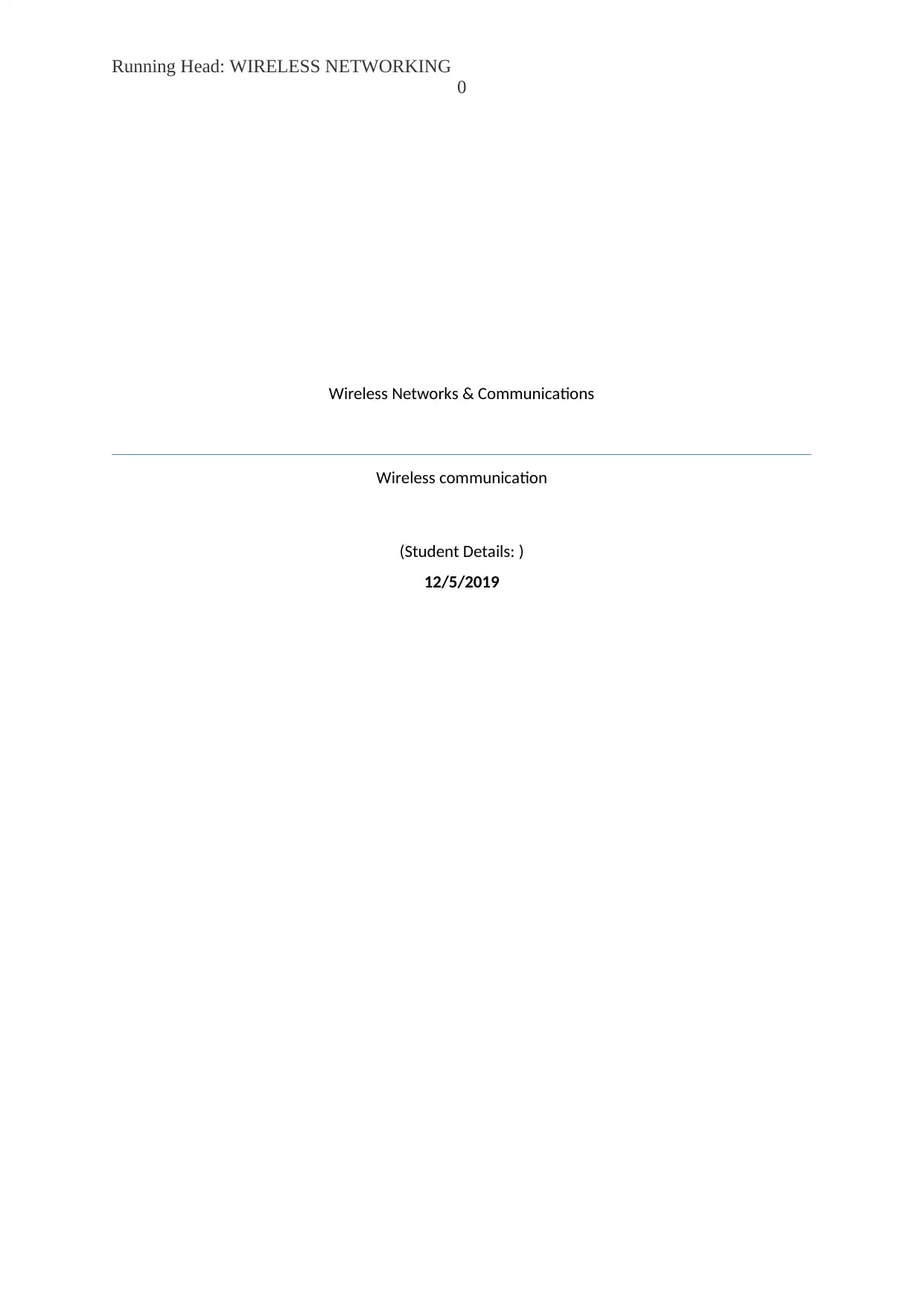
Running Head: WIRELESS NETWORKING
0
Wireless Networks & Communications
Wireless communication
(Student Details: )
12/5/2019
0
Wireless Networks & Communications
Wireless communication
(Student Details: )
12/5/2019
Paraphrase This Document
Need a fresh take? Get an instant paraphrase of this document with our AI Paraphraser
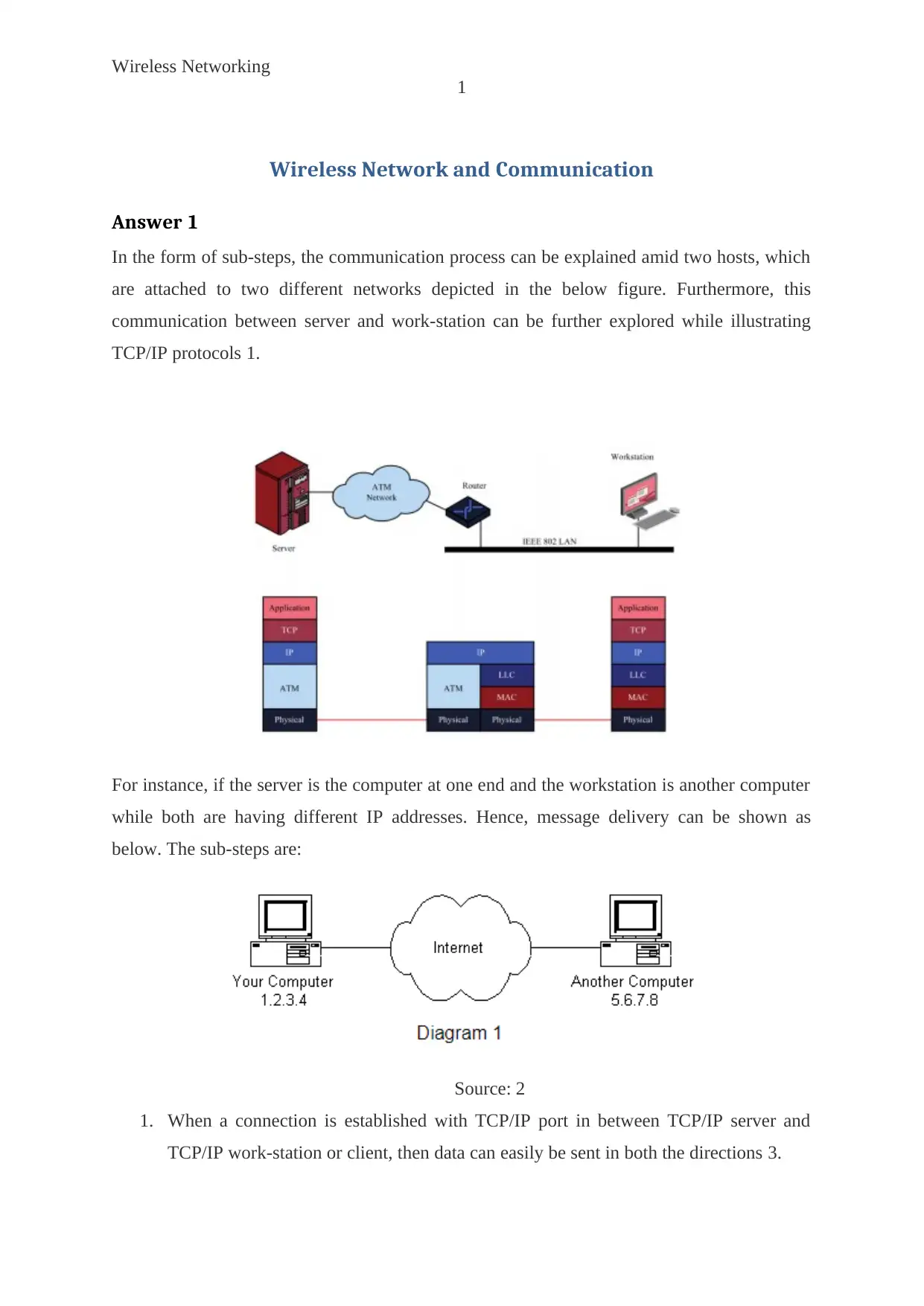
Wireless Networking
1
Wireless Network and Communication
Answer 1
In the form of sub-steps, the communication process can be explained amid two hosts, which
are attached to two different networks depicted in the below figure. Furthermore, this
communication between server and work-station can be further explored while illustrating
TCP/IP protocols 1.
For instance, if the server is the computer at one end and the workstation is another computer
while both are having different IP addresses. Hence, message delivery can be shown as
below. The sub-steps are:
Source: 2
1. When a connection is established with TCP/IP port in between TCP/IP server and
TCP/IP work-station or client, then data can easily be sent in both the directions 3.
1
Wireless Network and Communication
Answer 1
In the form of sub-steps, the communication process can be explained amid two hosts, which
are attached to two different networks depicted in the below figure. Furthermore, this
communication between server and work-station can be further explored while illustrating
TCP/IP protocols 1.
For instance, if the server is the computer at one end and the workstation is another computer
while both are having different IP addresses. Hence, message delivery can be shown as
below. The sub-steps are:
Source: 2
1. When a connection is established with TCP/IP port in between TCP/IP server and
TCP/IP work-station or client, then data can easily be sent in both the directions 3.
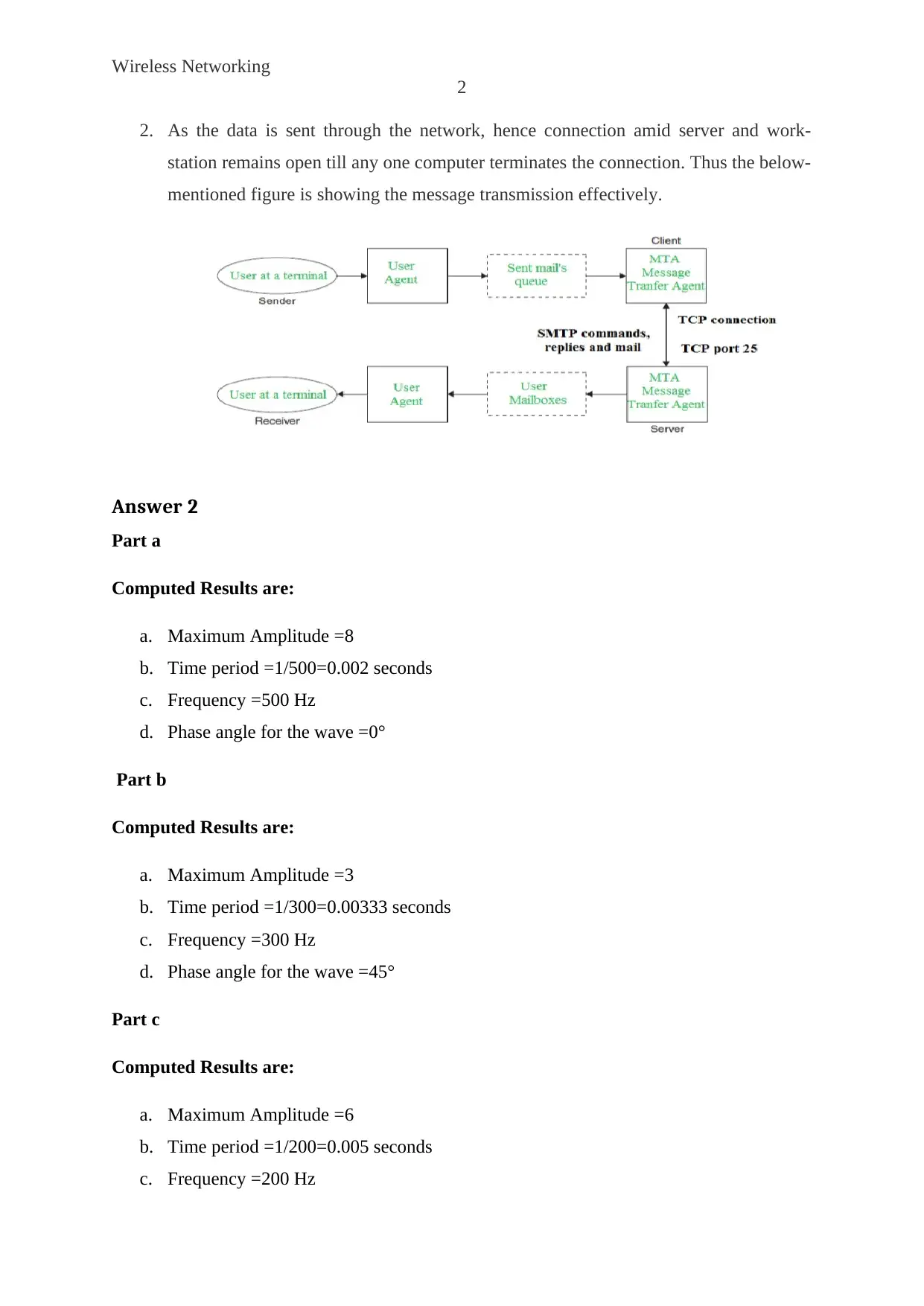
Wireless Networking
2
2. As the data is sent through the network, hence connection amid server and work-
station remains open till any one computer terminates the connection. Thus the below-
mentioned figure is showing the message transmission effectively.
Answer 2
Part a
Computed Results are:
a. Maximum Amplitude =8
b. Time period =1/500=0.002 seconds
c. Frequency =500 Hz
d. Phase angle for the wave =0°
Part b
Computed Results are:
a. Maximum Amplitude =3
b. Time period =1/300=0.00333 seconds
c. Frequency =300 Hz
d. Phase angle for the wave =45°
Part c
Computed Results are:
a. Maximum Amplitude =6
b. Time period =1/200=0.005 seconds
c. Frequency =200 Hz
2
2. As the data is sent through the network, hence connection amid server and work-
station remains open till any one computer terminates the connection. Thus the below-
mentioned figure is showing the message transmission effectively.
Answer 2
Part a
Computed Results are:
a. Maximum Amplitude =8
b. Time period =1/500=0.002 seconds
c. Frequency =500 Hz
d. Phase angle for the wave =0°
Part b
Computed Results are:
a. Maximum Amplitude =3
b. Time period =1/300=0.00333 seconds
c. Frequency =300 Hz
d. Phase angle for the wave =45°
Part c
Computed Results are:
a. Maximum Amplitude =6
b. Time period =1/200=0.005 seconds
c. Frequency =200 Hz
⊘ This is a preview!⊘
Do you want full access?
Subscribe today to unlock all pages.

Trusted by 1+ million students worldwide
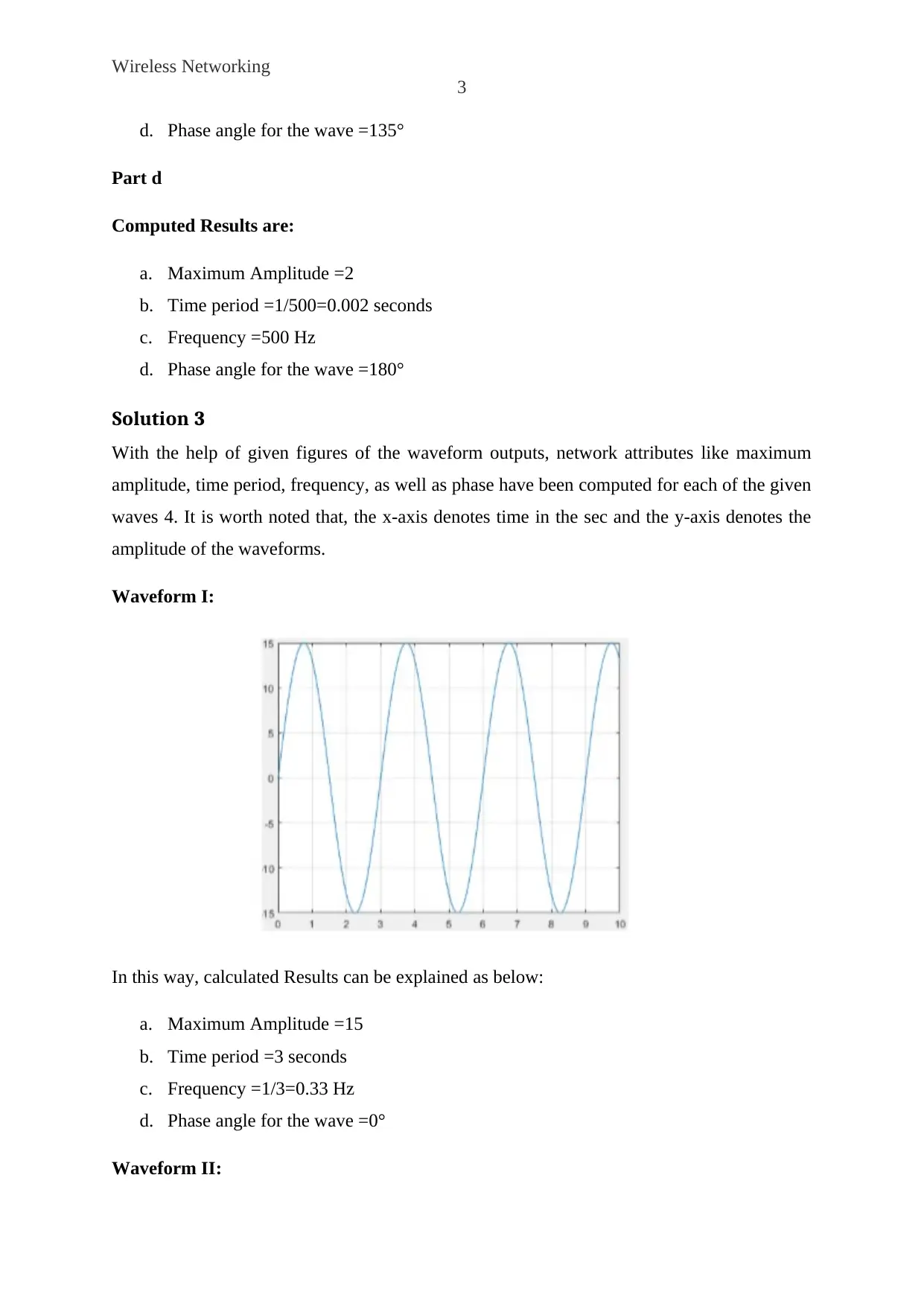
Wireless Networking
3
d. Phase angle for the wave =135°
Part d
Computed Results are:
a. Maximum Amplitude =2
b. Time period =1/500=0.002 seconds
c. Frequency =500 Hz
d. Phase angle for the wave =180°
Solution 3
With the help of given figures of the waveform outputs, network attributes like maximum
amplitude, time period, frequency, as well as phase have been computed for each of the given
waves 4. It is worth noted that, the x-axis denotes time in the sec and the y-axis denotes the
amplitude of the waveforms.
Waveform I:
In this way, calculated Results can be explained as below:
a. Maximum Amplitude =15
b. Time period =3 seconds
c. Frequency =1/3=0.33 Hz
d. Phase angle for the wave =0°
Waveform II:
3
d. Phase angle for the wave =135°
Part d
Computed Results are:
a. Maximum Amplitude =2
b. Time period =1/500=0.002 seconds
c. Frequency =500 Hz
d. Phase angle for the wave =180°
Solution 3
With the help of given figures of the waveform outputs, network attributes like maximum
amplitude, time period, frequency, as well as phase have been computed for each of the given
waves 4. It is worth noted that, the x-axis denotes time in the sec and the y-axis denotes the
amplitude of the waveforms.
Waveform I:
In this way, calculated Results can be explained as below:
a. Maximum Amplitude =15
b. Time period =3 seconds
c. Frequency =1/3=0.33 Hz
d. Phase angle for the wave =0°
Waveform II:
Paraphrase This Document
Need a fresh take? Get an instant paraphrase of this document with our AI Paraphraser
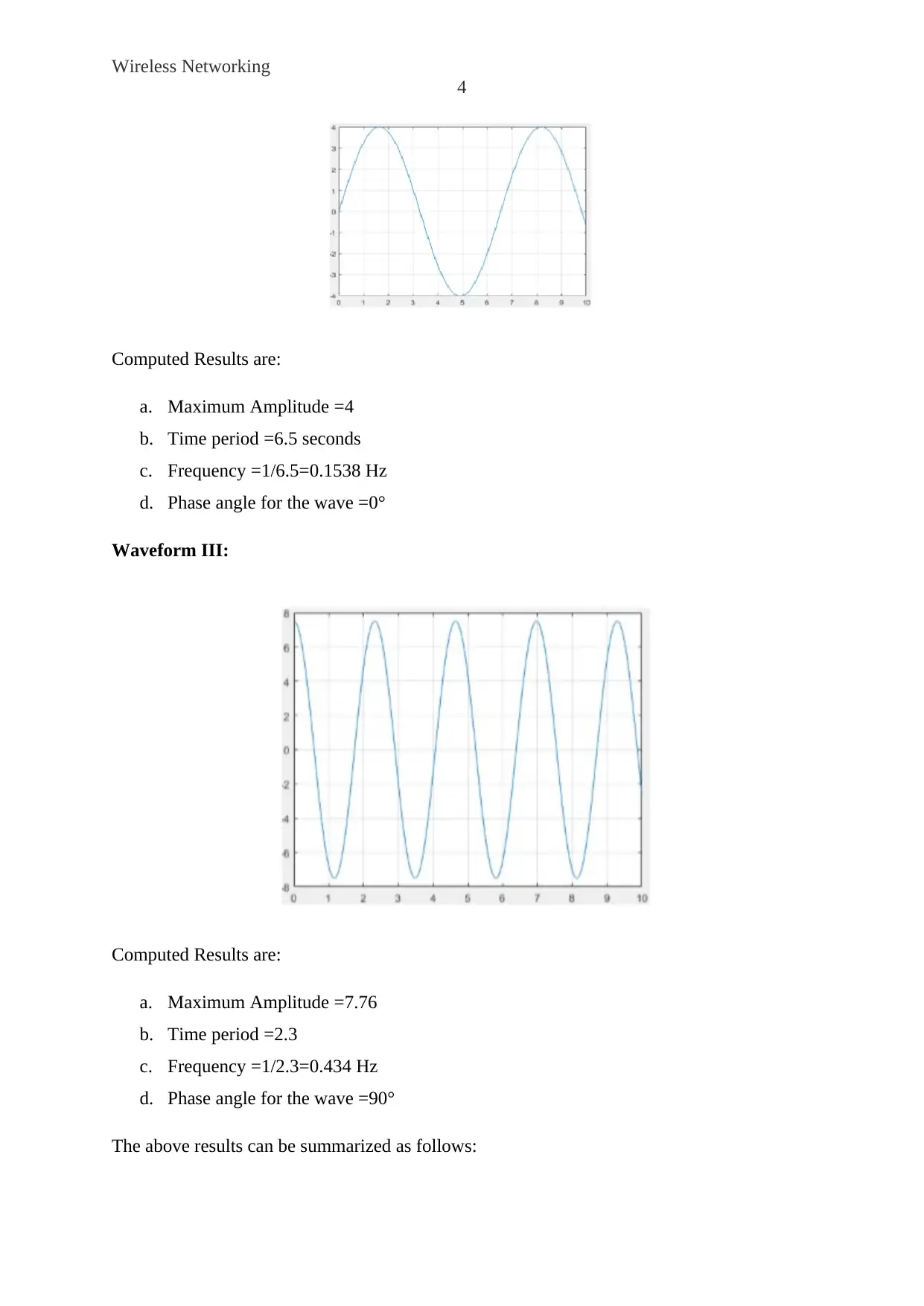
Wireless Networking
4
Computed Results are:
a. Maximum Amplitude =4
b. Time period =6.5 seconds
c. Frequency =1/6.5=0.1538 Hz
d. Phase angle for the wave =0°
Waveform III:
Computed Results are:
a. Maximum Amplitude =7.76
b. Time period =2.3
c. Frequency =1/2.3=0.434 Hz
d. Phase angle for the wave =90°
The above results can be summarized as follows:
4
Computed Results are:
a. Maximum Amplitude =4
b. Time period =6.5 seconds
c. Frequency =1/6.5=0.1538 Hz
d. Phase angle for the wave =0°
Waveform III:
Computed Results are:
a. Maximum Amplitude =7.76
b. Time period =2.3
c. Frequency =1/2.3=0.434 Hz
d. Phase angle for the wave =90°
The above results can be summarized as follows:
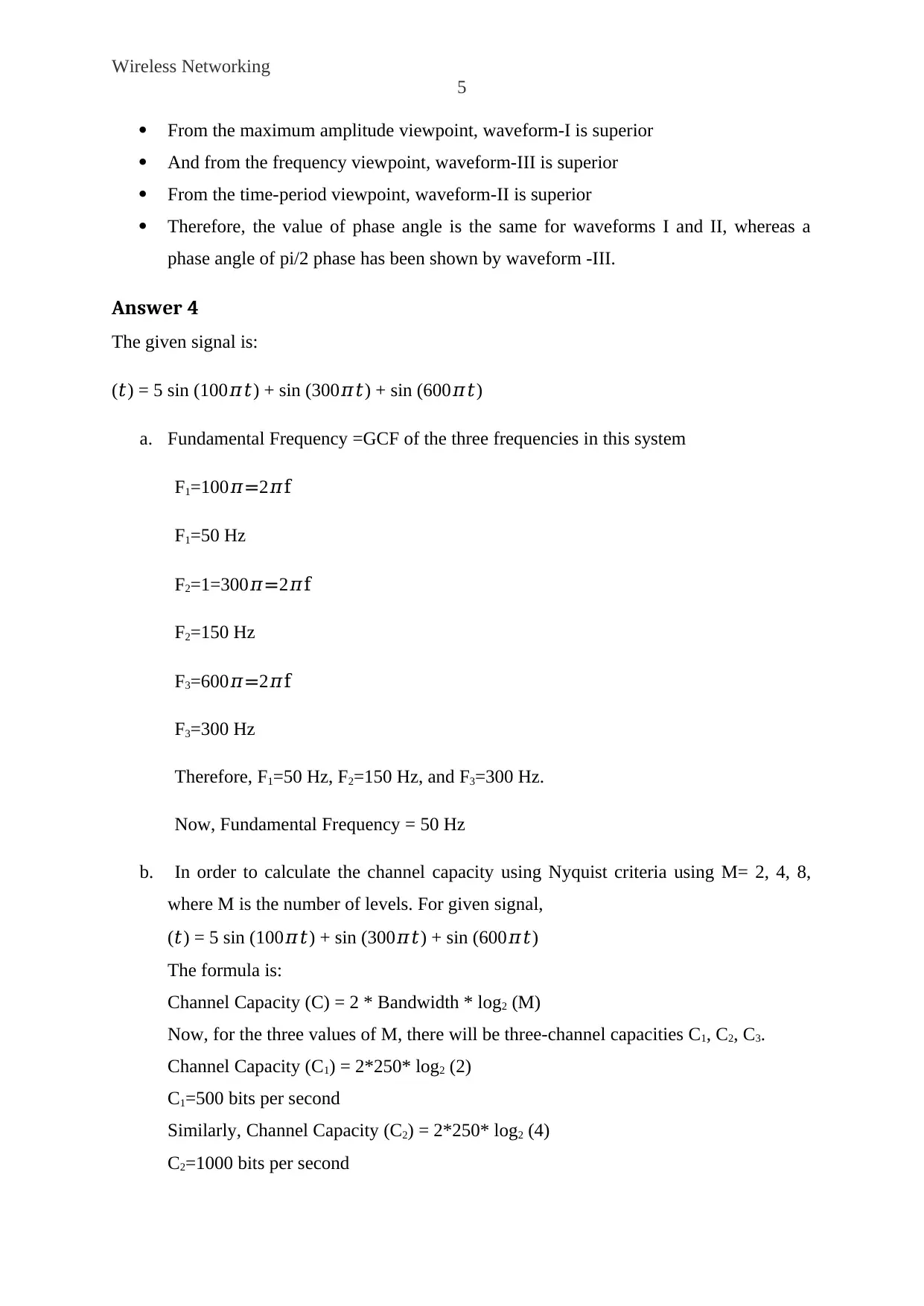
Wireless Networking
5
From the maximum amplitude viewpoint, waveform-I is superior
And from the frequency viewpoint, waveform-III is superior
From the time-period viewpoint, waveform-II is superior
Therefore, the value of phase angle is the same for waveforms I and II, whereas a
phase angle of pi/2 phase has been shown by waveform -III.
Answer 4
The given signal is:
(𝑡) = 5 sin (100𝜋𝑡) + sin (300𝜋𝑡) + sin (600𝜋𝑡)
a. Fundamental Frequency =GCF of the three frequencies in this system
F1=100𝜋=2𝜋f
F1=50 Hz
F2=1=300𝜋=2𝜋f
F2=150 Hz
F3=600𝜋=2𝜋f
F3=300 Hz
Therefore, F1=50 Hz, F2=150 Hz, and F3=300 Hz.
Now, Fundamental Frequency = 50 Hz
b. In order to calculate the channel capacity using Nyquist criteria using M= 2, 4, 8,
where M is the number of levels. For given signal,
(𝑡) = 5 sin (100𝜋𝑡) + sin (300𝜋𝑡) + sin (600𝜋𝑡)
The formula is:
Channel Capacity (C) = 2 * Bandwidth * log2 (M)
Now, for the three values of M, there will be three-channel capacities C1, C2, C3.
Channel Capacity (C1) = 2*250* log2 (2)
C1=500 bits per second
Similarly, Channel Capacity (C2) = 2*250* log2 (4)
C2=1000 bits per second
5
From the maximum amplitude viewpoint, waveform-I is superior
And from the frequency viewpoint, waveform-III is superior
From the time-period viewpoint, waveform-II is superior
Therefore, the value of phase angle is the same for waveforms I and II, whereas a
phase angle of pi/2 phase has been shown by waveform -III.
Answer 4
The given signal is:
(𝑡) = 5 sin (100𝜋𝑡) + sin (300𝜋𝑡) + sin (600𝜋𝑡)
a. Fundamental Frequency =GCF of the three frequencies in this system
F1=100𝜋=2𝜋f
F1=50 Hz
F2=1=300𝜋=2𝜋f
F2=150 Hz
F3=600𝜋=2𝜋f
F3=300 Hz
Therefore, F1=50 Hz, F2=150 Hz, and F3=300 Hz.
Now, Fundamental Frequency = 50 Hz
b. In order to calculate the channel capacity using Nyquist criteria using M= 2, 4, 8,
where M is the number of levels. For given signal,
(𝑡) = 5 sin (100𝜋𝑡) + sin (300𝜋𝑡) + sin (600𝜋𝑡)
The formula is:
Channel Capacity (C) = 2 * Bandwidth * log2 (M)
Now, for the three values of M, there will be three-channel capacities C1, C2, C3.
Channel Capacity (C1) = 2*250* log2 (2)
C1=500 bits per second
Similarly, Channel Capacity (C2) = 2*250* log2 (4)
C2=1000 bits per second
⊘ This is a preview!⊘
Do you want full access?
Subscribe today to unlock all pages.

Trusted by 1+ million students worldwide
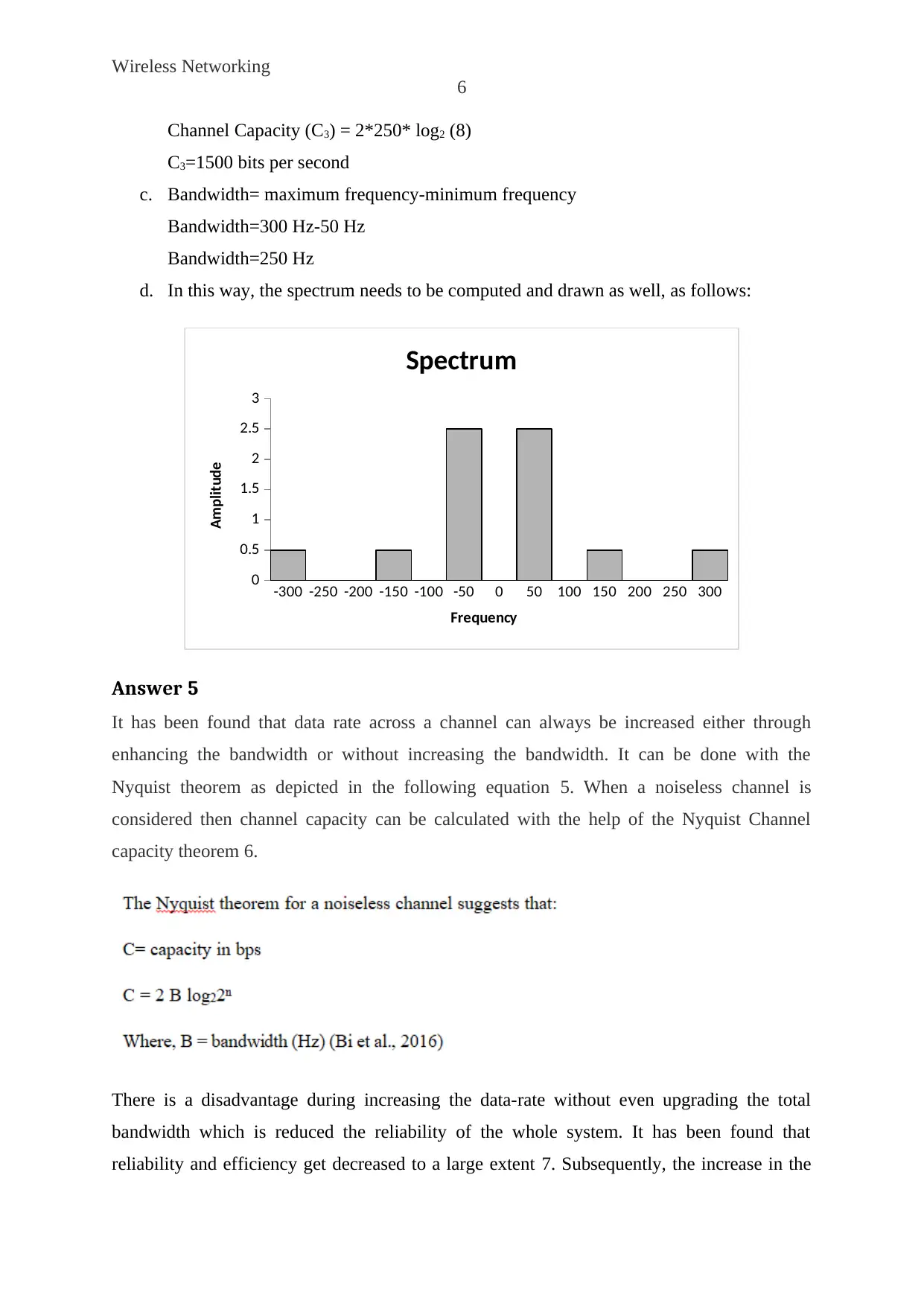
Wireless Networking
6
Channel Capacity (C3) = 2*250* log2 (8)
C3=1500 bits per second
c. Bandwidth= maximum frequency-minimum frequency
Bandwidth=300 Hz-50 Hz
Bandwidth=250 Hz
d. In this way, the spectrum needs to be computed and drawn as well, as follows:
-300 -250 -200 -150 -100 -50 0 50 100 150 200 250 300
0
0.5
1
1.5
2
2.5
3
Spectrum
Frequency
Amplitude
Answer 5
It has been found that data rate across a channel can always be increased either through
enhancing the bandwidth or without increasing the bandwidth. It can be done with the
Nyquist theorem as depicted in the following equation 5. When a noiseless channel is
considered then channel capacity can be calculated with the help of the Nyquist Channel
capacity theorem 6.
There is a disadvantage during increasing the data-rate without even upgrading the total
bandwidth which is reduced the reliability of the whole system. It has been found that
reliability and efficiency get decreased to a large extent 7. Subsequently, the increase in the
6
Channel Capacity (C3) = 2*250* log2 (8)
C3=1500 bits per second
c. Bandwidth= maximum frequency-minimum frequency
Bandwidth=300 Hz-50 Hz
Bandwidth=250 Hz
d. In this way, the spectrum needs to be computed and drawn as well, as follows:
-300 -250 -200 -150 -100 -50 0 50 100 150 200 250 300
0
0.5
1
1.5
2
2.5
3
Spectrum
Frequency
Amplitude
Answer 5
It has been found that data rate across a channel can always be increased either through
enhancing the bandwidth or without increasing the bandwidth. It can be done with the
Nyquist theorem as depicted in the following equation 5. When a noiseless channel is
considered then channel capacity can be calculated with the help of the Nyquist Channel
capacity theorem 6.
There is a disadvantage during increasing the data-rate without even upgrading the total
bandwidth which is reduced the reliability of the whole system. It has been found that
reliability and efficiency get decreased to a large extent 7. Subsequently, the increase in the
Paraphrase This Document
Need a fresh take? Get an instant paraphrase of this document with our AI Paraphraser
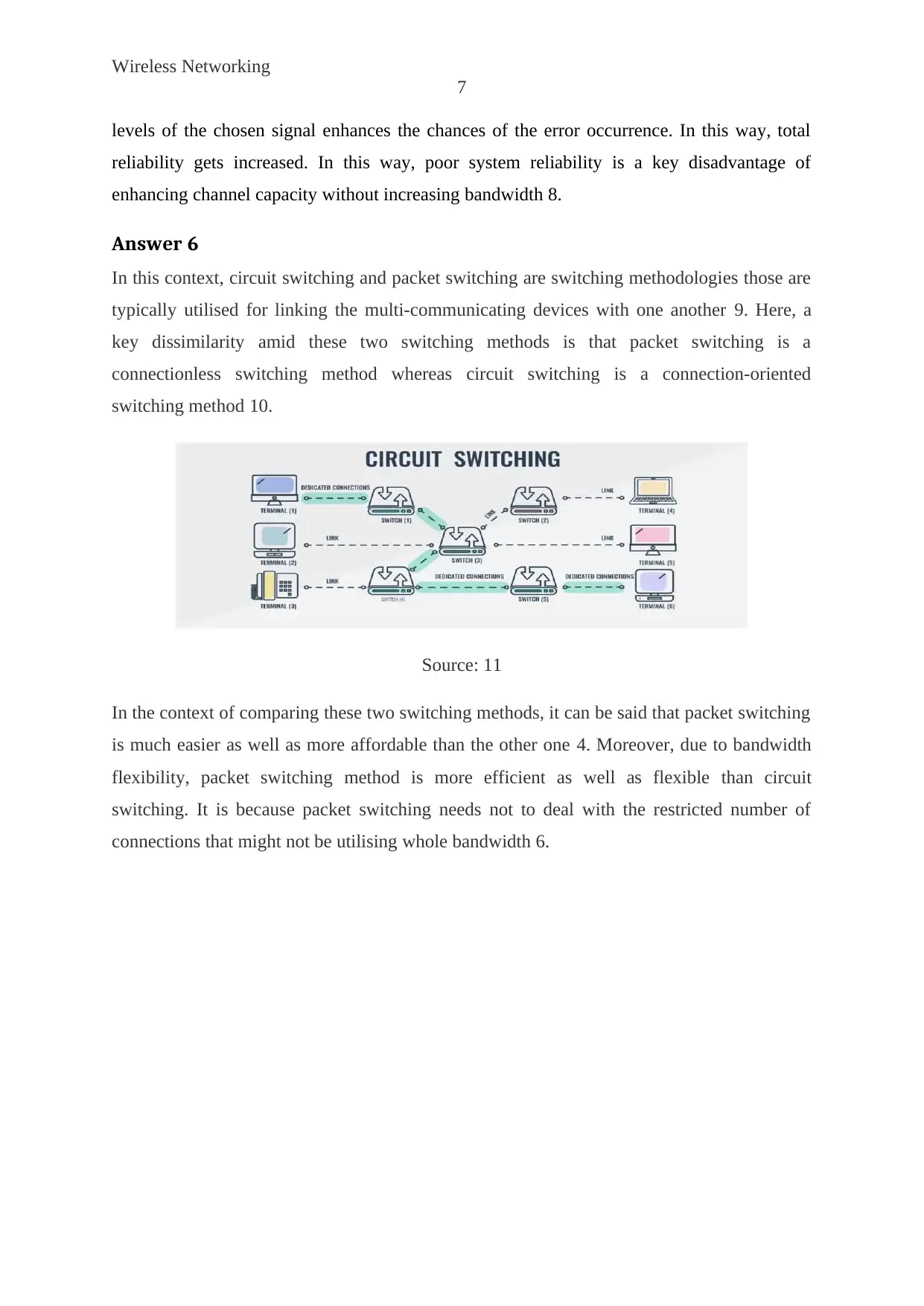
Wireless Networking
7
levels of the chosen signal enhances the chances of the error occurrence. In this way, total
reliability gets increased. In this way, poor system reliability is a key disadvantage of
enhancing channel capacity without increasing bandwidth 8.
Answer 6
In this context, circuit switching and packet switching are switching methodologies those are
typically utilised for linking the multi-communicating devices with one another 9. Here, a
key dissimilarity amid these two switching methods is that packet switching is a
connectionless switching method whereas circuit switching is a connection-oriented
switching method 10.
Source: 11
In the context of comparing these two switching methods, it can be said that packet switching
is much easier as well as more affordable than the other one 4. Moreover, due to bandwidth
flexibility, packet switching method is more efficient as well as flexible than circuit
switching. It is because packet switching needs not to deal with the restricted number of
connections that might not be utilising whole bandwidth 6.
7
levels of the chosen signal enhances the chances of the error occurrence. In this way, total
reliability gets increased. In this way, poor system reliability is a key disadvantage of
enhancing channel capacity without increasing bandwidth 8.
Answer 6
In this context, circuit switching and packet switching are switching methodologies those are
typically utilised for linking the multi-communicating devices with one another 9. Here, a
key dissimilarity amid these two switching methods is that packet switching is a
connectionless switching method whereas circuit switching is a connection-oriented
switching method 10.
Source: 11
In the context of comparing these two switching methods, it can be said that packet switching
is much easier as well as more affordable than the other one 4. Moreover, due to bandwidth
flexibility, packet switching method is more efficient as well as flexible than circuit
switching. It is because packet switching needs not to deal with the restricted number of
connections that might not be utilising whole bandwidth 6.
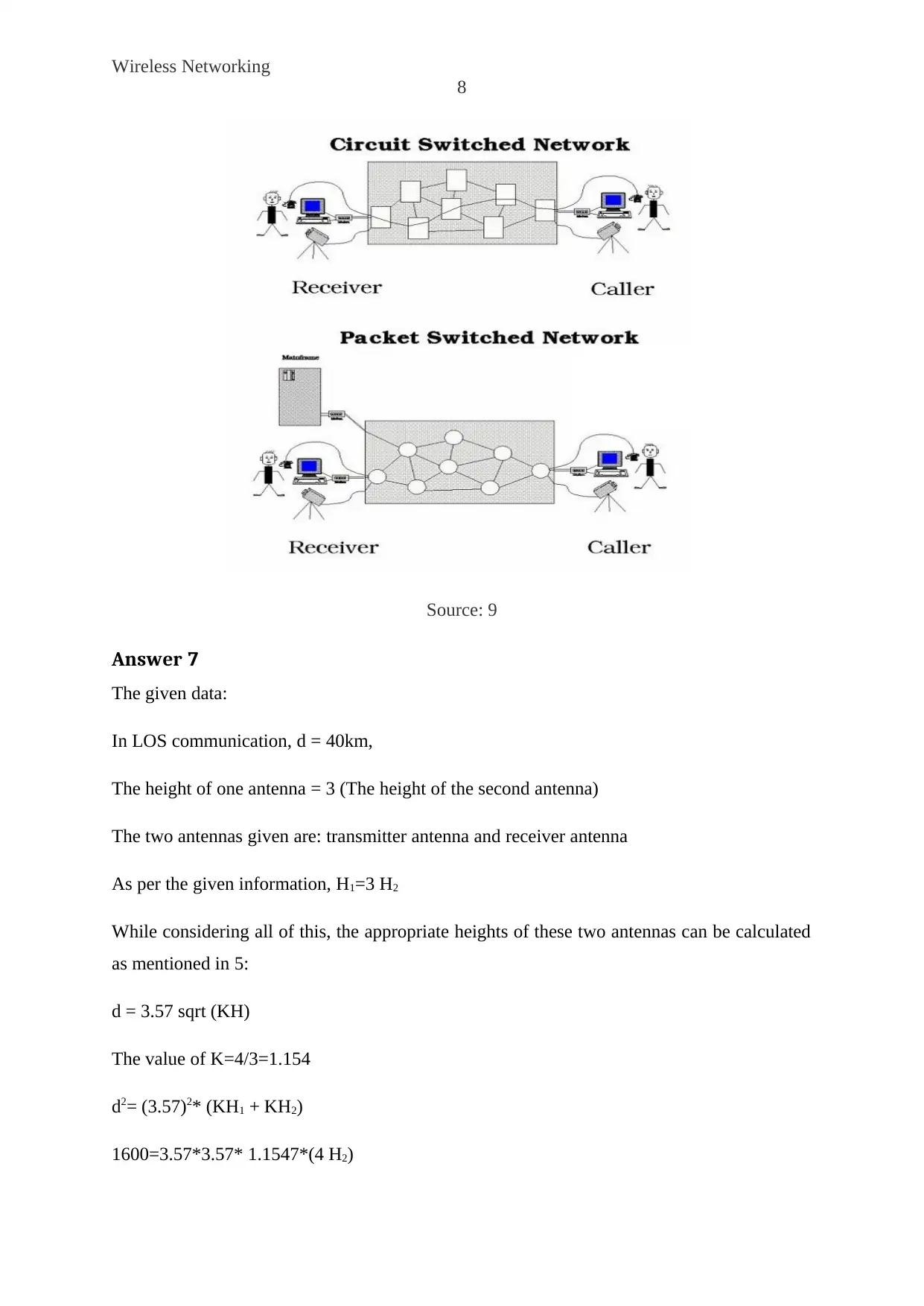
Wireless Networking
8
Source: 9
Answer 7
The given data:
In LOS communication, d = 40km,
The height of one antenna = 3 (The height of the second antenna)
The two antennas given are: transmitter antenna and receiver antenna
As per the given information, H1=3 H2
While considering all of this, the appropriate heights of these two antennas can be calculated
as mentioned in 5:
d = 3.57 sqrt (KH)
The value of K=4/3=1.154
d2= (3.57)2* (KH1 + KH2)
1600=3.57*3.57* 1.1547*(4 H2)
8
Source: 9
Answer 7
The given data:
In LOS communication, d = 40km,
The height of one antenna = 3 (The height of the second antenna)
The two antennas given are: transmitter antenna and receiver antenna
As per the given information, H1=3 H2
While considering all of this, the appropriate heights of these two antennas can be calculated
as mentioned in 5:
d = 3.57 sqrt (KH)
The value of K=4/3=1.154
d2= (3.57)2* (KH1 + KH2)
1600=3.57*3.57* 1.1547*(4 H2)
⊘ This is a preview!⊘
Do you want full access?
Subscribe today to unlock all pages.

Trusted by 1+ million students worldwide

Wireless Networking
9
1600=58.866 H2
In this way, the value of H2= 27.180 m
As we know, H1= 3 H2
Therefore, H1=81.541 m
9
1600=58.866 H2
In this way, the value of H2= 27.180 m
As we know, H1= 3 H2
Therefore, H1=81.541 m
Paraphrase This Document
Need a fresh take? Get an instant paraphrase of this document with our AI Paraphraser
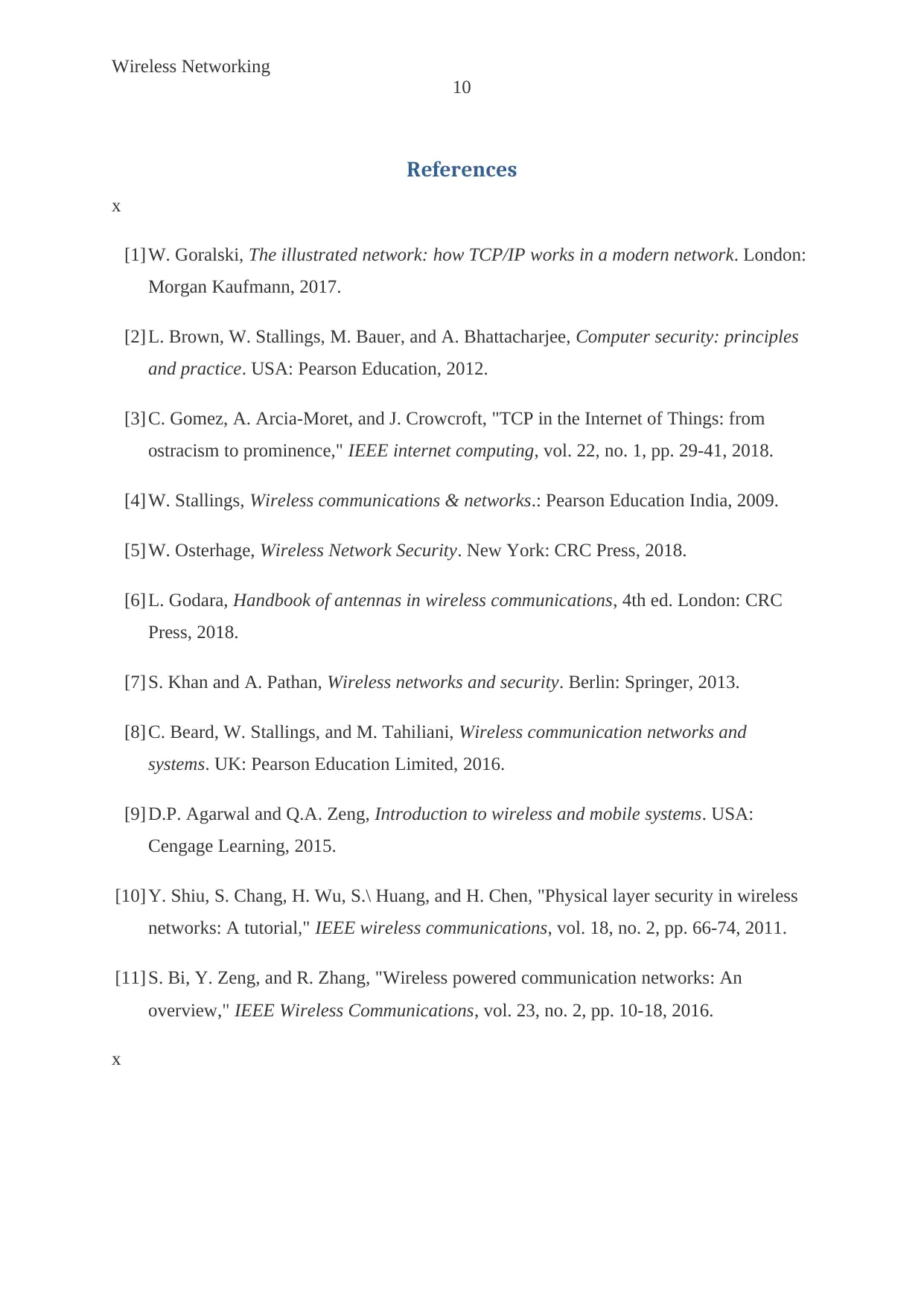
Wireless Networking
10
References
x
[1] W. Goralski, The illustrated network: how TCP/IP works in a modern network. London:
Morgan Kaufmann, 2017.
[2] L. Brown, W. Stallings, M. Bauer, and A. Bhattacharjee, Computer security: principles
and practice. USA: Pearson Education, 2012.
[3] C. Gomez, A. Arcia-Moret, and J. Crowcroft, "TCP in the Internet of Things: from
ostracism to prominence," IEEE internet computing, vol. 22, no. 1, pp. 29-41, 2018.
[4] W. Stallings, Wireless communications & networks.: Pearson Education India, 2009.
[5] W. Osterhage, Wireless Network Security. New York: CRC Press, 2018.
[6] L. Godara, Handbook of antennas in wireless communications, 4th ed. London: CRC
Press, 2018.
[7] S. Khan and A. Pathan, Wireless networks and security. Berlin: Springer, 2013.
[8] C. Beard, W. Stallings, and M. Tahiliani, Wireless communication networks and
systems. UK: Pearson Education Limited, 2016.
[9] D.P. Agarwal and Q.A. Zeng, Introduction to wireless and mobile systems. USA:
Cengage Learning, 2015.
[10] Y. Shiu, S. Chang, H. Wu, S.\ Huang, and H. Chen, "Physical layer security in wireless
networks: A tutorial," IEEE wireless communications, vol. 18, no. 2, pp. 66-74, 2011.
[11] S. Bi, Y. Zeng, and R. Zhang, "Wireless powered communication networks: An
overview," IEEE Wireless Communications, vol. 23, no. 2, pp. 10-18, 2016.
x
10
References
x
[1] W. Goralski, The illustrated network: how TCP/IP works in a modern network. London:
Morgan Kaufmann, 2017.
[2] L. Brown, W. Stallings, M. Bauer, and A. Bhattacharjee, Computer security: principles
and practice. USA: Pearson Education, 2012.
[3] C. Gomez, A. Arcia-Moret, and J. Crowcroft, "TCP in the Internet of Things: from
ostracism to prominence," IEEE internet computing, vol. 22, no. 1, pp. 29-41, 2018.
[4] W. Stallings, Wireless communications & networks.: Pearson Education India, 2009.
[5] W. Osterhage, Wireless Network Security. New York: CRC Press, 2018.
[6] L. Godara, Handbook of antennas in wireless communications, 4th ed. London: CRC
Press, 2018.
[7] S. Khan and A. Pathan, Wireless networks and security. Berlin: Springer, 2013.
[8] C. Beard, W. Stallings, and M. Tahiliani, Wireless communication networks and
systems. UK: Pearson Education Limited, 2016.
[9] D.P. Agarwal and Q.A. Zeng, Introduction to wireless and mobile systems. USA:
Cengage Learning, 2015.
[10] Y. Shiu, S. Chang, H. Wu, S.\ Huang, and H. Chen, "Physical layer security in wireless
networks: A tutorial," IEEE wireless communications, vol. 18, no. 2, pp. 66-74, 2011.
[11] S. Bi, Y. Zeng, and R. Zhang, "Wireless powered communication networks: An
overview," IEEE Wireless Communications, vol. 23, no. 2, pp. 10-18, 2016.
x

Wireless Networking
11
11
⊘ This is a preview!⊘
Do you want full access?
Subscribe today to unlock all pages.

Trusted by 1+ million students worldwide
1 out of 12
Related Documents
Your All-in-One AI-Powered Toolkit for Academic Success.
+13062052269
info@desklib.com
Available 24*7 on WhatsApp / Email
![[object Object]](/_next/static/media/star-bottom.7253800d.svg)
Unlock your academic potential
Copyright © 2020–2025 A2Z Services. All Rights Reserved. Developed and managed by ZUCOL.





